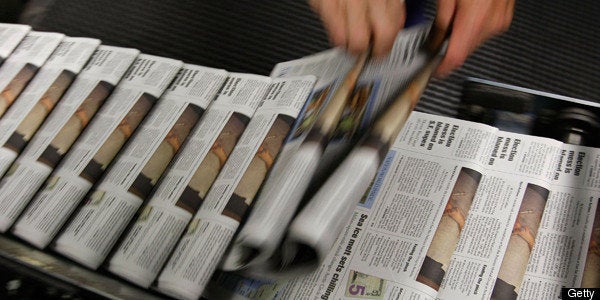
Are newspapers dead or are they finally waking up to the fact that readers are their most important customers?
Americans have a love-hate relationship with newspapers going back decades if not centuries. It's like that love affair with a beautiful women we can never quite understand. The one who inspires us and infuriates us by turns. And yet now, in 2011, we have almost managed to swear her off, as Internet blogs with youth and beauty (and no journalistic ethics) take her place. And then The New York Times, embodying all that the apple of our eye ever aspired to be, goes and puts up a pay wall on their digital edition. Is this one more death rattle or a fundamental change in our relationship to newspapers?
Why do we hate newspapers? Because they are right wing (Rupert Murdoch) or because they are left wing (most of the major metros on the East Coast according to Murdoch)? No it's because they aspire to keep us, as a society, honest. They aspire to tell the deep, ugly truth. If there is an elephant in the living room, their goal is to find it. If you ask any journalist, they care most about getting it right, not getting rich. We love and hate these men and women for their heroism.
I was the Chief Financial Officer of The Providence Journal Company in the mid-1990s, hired by Stephen Hamblett, the first non-family CEO in nearly two centuries. Michael Metcalf, the prior CEO, died suddenly on his bike, riding up hill, just after the paper had written a long series of stories detailing the connection between organized crime and certain Rhode Island politicians. As his beloved paper reported at the time, "Another cyclist discovered Metcalf lying in the road, unconscious and bleeding with a head injury. He was next to his undamaged bike, about 1 1/2 miles from home. Surgery at St. Anne Hospital in Fall River could not save him, and Metcalf died a week later, at age 54, never having regained consciousness." Many, including members of the Metcalf family, were convinced then, and remain convinced to this day, that Michael died not by accident but for telling the truth.
We also hate that this noble effort -- the journalistic impulse which brought down the Presidency during Watergate and just killed photo-journalist Timothy Hetherington, who did more than any Army press conference to show Americans the truth of what has been happening during the wars in Iraq, Afghanistan, and now Libya where he died covering combat -- has to get mucked up with business. I had the misfortune of architecting the sale of The Providence Journal to Belo in 1996 for $2 billion. Even those who stood to gain the most financially treated me as if I had dared kill their first-born. The community outrage led to death threats. I had violated a community trust.
Our collective disgust at mixing business with journalism has become even more profound as the last decade and a half has ground the great old newspapers of the country into a scrap heap of mush. The management of these organizations reacted to the discomfort of mixing high-minded journalism and making money by maintaining a wall between the two. Amazingly, they have yet to figure out who their real customers are.
Historically newspapers have generated the lion's share of their revenue and profit from advertisements. So the thinking went: as ad dollars dropped off a cliff the only way to continue to make money was to slash the amount spent on editorial. Papers got thinner and thinner on news, readers got more and more dissatisfied, and advertising dollars continued to plummet. A death spiral was born.
I know, I know: let's get to the passionate kiss at the end of this love story.
We all still want to read newspapers, even kids (my 15 year-old son studies the Red Sox box score every summer morning). We may want to read it online or to be able to comment on our favorite columnist's piece or watch a video. But we trust that the journalists at the Wall Street Journal or The New York Times are cut from a different cloth than some blogger on Gawker. They are actually out to tell us the truth, whether we like it or not. The only rub is how to pay for it. For the first time my local paper, The Boston Globe, is generating more revenue from reader subscriptions than from advertising. As it should be, I say.
As long as we continue to believe that advertisers should pay for news reporting the love our life is doomed to certain death. Free news does not mean reliable news. It most often means schlock opinion. Great journalism is something you and I are going to have to pay for, like HBO or Cooks Illustrated (the best food magazine there is pure editorial).
So yes, the Times pay wall is a fundamental redefinition in our relationship with the news organizations that we have coveted for generations. But there is no longer an uncomfortable ménage à trois between newspapers, readers and advertisers. It's monogamy at last. Newspapers have to focus all their energy on producing extraordinary journalism -- in a form and in substance -- which thrills us as consumers. The product is no longer a nicotine delivery system. Taste and quality information, the truth as determined by rigorous reporting, is the only objective. Not selling cars or sofas.
So fear not. Your paper is not dead. You just have to demand, and be willing to pay for, a news product worthy of your affections.
Fade to sunset as the doctor tells the beautiful young women that her water-melon-sized-malignant tumor has miraculously disappeared and husband and wife embrace as if for the first time, kissing with open mouths and hearts.
Originally published in The Good Men Project